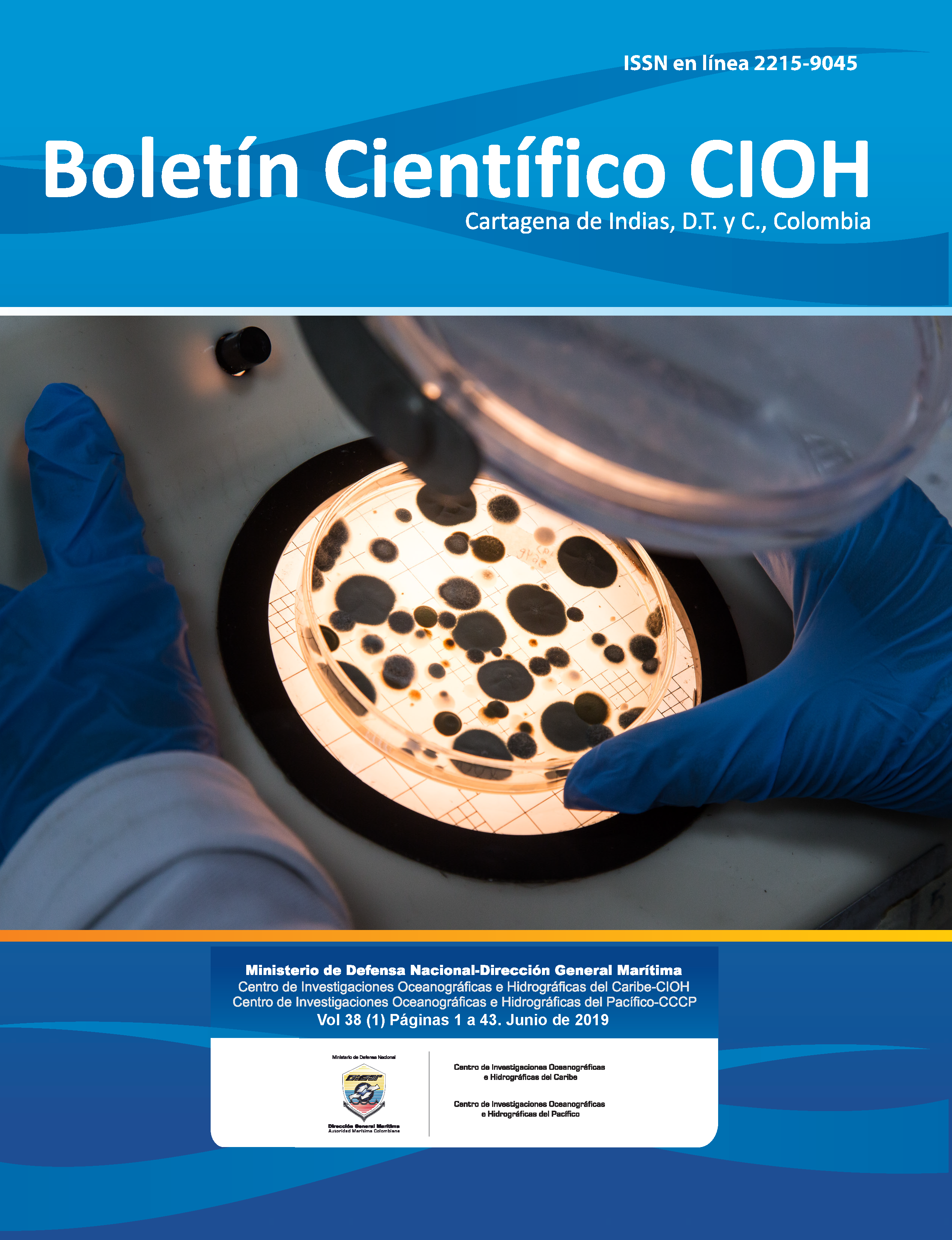EVALUATION OF THE RISK GENERATED BY INVASIVE SPECIES INTRODUCED THROUGH BALLAST WATER IN TWO PORTS OF THE COLOMBIAN PACIFIC
DOI:
https://doi.org/10.26640/22159045.2019.519Abstract
The International Maritime Organization (IMO) has established guidelines to face the problem of biological contamination in coastal areas generated by the ballast water vector. Among these guidelines, several models have been established to assess the risk of introducing species into new areas, including: discharge frequency (C1), ballast water discharged in port volumes (C2); and, environmental similarity between the port of origin with the receiving port (C3). Based on the IMO model and the information contained in the Ballast Water Notification forms, sent to the General Maritime Directorate in compliance with Resolution 477/2012, the risk level for Tumaco and Buenaventura ports was established. During 2015, ballast water with the highest shedding frequency in the port of Tumaco came from Long Beach (USA), being 13.4\% of the total discharge (C1). For the port of Buenaventura, this percentage was represented by waters from Manta (Ecuador) and Puerto Caldera (Costa Rica), with percentages of 19.56\% and 18.47\%, respectively. Tumaco imported around 310\,062 $m^{3}$ of ballast water and Buenaventura about 132,294 $m^{3}$, which corresponded to 176 unloaded tanks, coming from 14 ports with origin in twelve countries for Tumaco and 184 tanks from 12 ports of origin in six countries for Buenaventura (C2). Regarding the environmental similarity (C3), it could be deduced that San José-Guatemala (0.99) and Buenaventura-Colombia (0.99), presented greater similarity with the port of Tumaco, followed by Talara-Peru (0.98), La Pampilla- Peru (0.89) and Los Angeles-USA (0.89); while for Buenaventura the greatest similarity was presented by the ports located in Puerto Quetzal-Guatemala (0.99) and Caldera-Costa Rica (0.97).Downloads
References
Clarke, C., Hilliard, R., Junqueira, A., Neto, A., Polglaze, J., & Raaymarkers, S. (2003). Ballast Water Risk Assessment Port of Sepetiba Federal Republic of Brazil: Final Report. Globallast Monograph Series No. 14. International Maritime Organization, Global Ballast Water Management Programme, London.
Dirección General Marítima-DIMAR. (2012, 09 06). Resolución 477 de 2012. Bogotá D.C., Colombia.
GEF/UNDP/IMO Global Ballast Water Management Programme. (2003). User guide for the BWRA Database/GIS System. Londres (Reino Unido).
GEF-UNDP-IMO GloBallast Partnerships Programme and WMU. (2013). Identifying and Managing Risks from Organisms Carried in Ships Ballast Water - GloBallast Monograph No. 21. Londres.
Gollasch , S., Lenz, J., Dammer, M., & Andres, H.-G. (2000). Survival of tropical ballast water organisms during a cruise from the Indian Ocean to the North Sea. Journal of Plankton Research, 923–937.
Gollasch, S., & Leppäkoski, E. (2007). Risk assessment and management scenarios for ballast water mediated species introductions into the Baltic Sea. Aquatic Invasions, 2, 313-340. doi:10.3391/ai.2007.2.4.3
Gollasch, S., & Nehring, S. (2006, Diciembre). National checklist for aquatic alien species in Germany. Aquatic Invasions, 1, 245-269. doi:10.3391
Invasive Species Specialist Group. (2015, 11). GLOBAL INVASIVE SPECIES DATABASE. Retrieved from GLOBAL INVASIVE SPECIES DATABASE.
Joachimsthal, E., Ivanov, V., Tay, S., & Tay, J.-H. (2004, Agosto). Bacteriological examination of ballast water in Singapore Harbour by flow cytometry with FISH. Marine Pollution Bulletin, 49, 334-343. doi:https://doi.org/10.1016/j.marpolbul.2004.02.036
Lavoie, D., Smith, L., & Ruiz, G. (1999). The Potential for Intracoastal Transfer of Non-indigenous Species in the Ballast Water of Ships. Estuarine, Coastal and Shelf Science, 551–564.
Matej, D., Gollasch, S., & Leppäkoski, E. (2013). Risk assessment for exemptions from ballast water management – The Baltic Sea case study. Marine Pollution Bulletin, 205–217.
Ministerio de Ambiente Perú. (2015, 07 29). Ministerio Ambiente Perú. Retrieved from http://www.minam.gob.pe/diversidadbiologica/problematica/instrumentos-de-gestion-de-la-diversidad-biologica/especies-exoticas-invasoras/
Organización Marítima Internacional. (2019). OMI Organización Marítima Internacional. Retrieved from http://www.imo.org/es/OurWork/Environment/BallastWaterManagement/Paginas/Default.aspx
Organización Marítima Internacional. (2019). Organización Marítima Internacional. Retrieved from http://www.imo.org/es/About/Conventions/ListOfConventions/Paginas/International-Convention-for-the-Control-and-Management-of-Ships%27-Ballast-Water-and-Sediments-(BWM).aspx
Rahel, F., & Olden, J. (2008). Assessing the Effects of Climate Change on Aquatic Invasive Species. Conservation Biology, 22, 521–533.
Downloads
Published
Issue
Section
License
Copyright (c) 2019 Boletín Científico CIOH

This work is licensed under a Creative Commons Attribution-NonCommercial-NoDerivatives 4.0 International License.
Attribution — You must give appropriate credit, provide a link to the license, and indicate if changes were made. You may do so in any reasonable manner, but not in any way that suggests the licensor endorses you or your use.
NonCommercial — You may not use the material for commercial purposes.
NoDerivatives — If you remix, transform, or build upon the material, you may not distribute the modified material.
No additional restrictions — You may not apply legal terms or technological measures that legally restrict others from doing anything the license permits.



